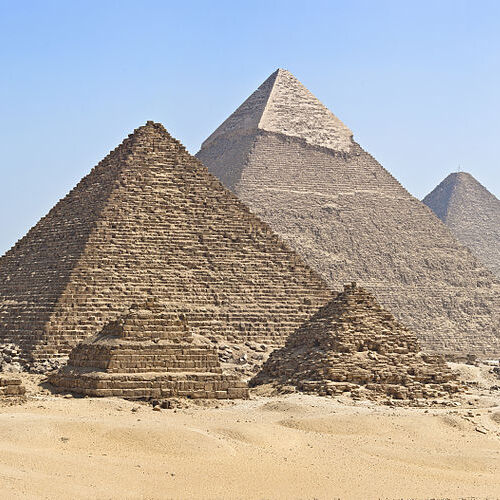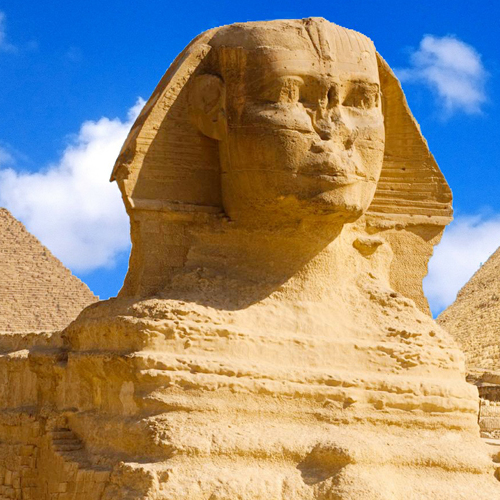No other nation in the world says ‘Welcome’ as often as the Egyptians, and every time, they mean it. While the ancient civilization of Egypt continues to amaze, contemporary Egyptians are equally remarkable.
The Giza Plateau
Unveiling the Mysteries of the Giza Plateau: Where Ancient Majesty Meets Modern Cairo
The Giza Plateau, an enigmatic expanse of history, lies to the north of Memphis‘ necropolis, nestled along the west bank of the majestic Nile. Today, it is a part of the bustling suburbs of modern Cairo. As you embark on your journey to explore the Giza pyramids for the first time, you anticipate the awe-inspiring moment of standing before these colossal structures, rising from the desert sands like ancient guardians of time. Yet, the greatest surprise unfolds as you turn around, only to find the rapidly growing city’s skyscrapers, as if in a race to outshine their ancient neighbors.
In the annals of Egypt’s rich heritage, Abydos once served as the royal burial grounds for the earliest dynasties. However, during the reign of Dynasty I, high officials chose to establish their tombs in Saqqara, a site close to the capital city of Memphis. Curiously, even in those ancient times, Giza seemed to have been employed as a burial ground. The earliest known tomb, Mastaba V, believed to date back to the reign of Dynasty I’s King Djet, sits amidst fifty-six surrounding graves, suggesting the occupant’s high status. Notably, a tomb from Dynasty II at Giza bears inscriptions naming King Nynetjer on its early dynastic jar sealings.
Saqqara, the principal Memphite necropolis, was immortalized by Djoser-Netjerikhet with the construction of the first royal tomb built in step-like pyramid form. However, as this city of the dead became increasingly populated, kings and high officials began to seek new resting places, marking the birth of Zawyet el-Aryan, Meidum, and Dashur as burial grounds. It was during Dynasty IV that King Khufu (known as Cheops in Greek) took the monumental step of constructing his pyramid at Giza, now renowned as the ‘Great Pyramid’—the sole surviving structure among the seven ancient wonders of the world. In its time, Khufu‘s pyramid stood as the world’s tallest edifice, reigning supreme until the early 20th century AD.
The Giza Plateau, home to three famous pyramids, includes not only Khufu’s renowned monument but also those of his son, Khafre (known as Chephren in Greek), and Menkaure (known as Mycerinus in Greek). Khafre’s pyramid, though appearing taller at a distance, is an illusion, a product of its elevated construction site. Menkaure’s pyramid, the smallest of the trio, completes the impressive triad. When initially built, these pyramids gleamed, their white limestone casings radiating brilliantly across the desert. Over time, most of these casings were lost to ancient robbers, although traces can still be seen on the summit of Khafre’s pyramid.
The Giza pyramids have captivated humanity for centuries, sparking countless mysteries and theories. Even Napoleon Bonaparte, when he conquered Egypt in 1798, stood in awe of these structures when they stood majestically isolated in the desert. They have been christened with various names, from the ‘Granaries of Joseph’ to the ‘Mountains of the Pharaohs.’ Numerous theories about their origins abound, ranging from attributing their construction to lost civilizations like the Atlanteans to speculations about extraterrestrial involvement. Questions persist about their construction methods and their orientation—whether cosmic or religious in nature.
Each pyramid complex boasts associated structures: satellite pyramids, mortuary temples, causeways, and valley temples, although not all remain visible today. Of particular note, Khufu and Khafre’s pyramids featured boat pits alongside them, housing disassembled, full-sized wooden boats. Khufu’s ‘solar boat,’ discovered in 1954, has been painstakingly reassembled over the years and is now displayed in its dedicated museum south of the pyramid.
The plateau’s vast cemeteries feature mastaba tombs—large rectangular superstructures constructed over deep burial shafts. These mastabas, often laid out in street-like rows, housed the elite of the Old Kingdom, buried in proximity to their pharaohs. The eastern and western sides of Khufu’s pyramid hosted extensive cemeteries during this era. Additionally, private tombs were carved into quarries surrounding Khafre and Menkaure’s pyramids.
Numerous Old Kingdom tombs at Giza offer visitors a chance to step into the past. These tombs are adorned with spectacular reliefs, intricately carved hieroglyphs, and engaging statues of their owners, bearing testimony to the artistic zenith achieved during the Old Kingdom.
Yet, Giza’s fame extends beyond its pyramids. The Great Sphinx, situated near Khafre’s causeway and valley temple, stands as one of the world’s most iconic monuments. This colossal royal statue, carved from a natural limestone outcrop left by the builders of the Great Pyramid, boasts the body of a crouching lion and a human head. It stretches 73 meters in length and rises over 20 meters in height. Known as ‘Abu Hol,’ or ‘Father of Terror,’ to the Arabic people, the Sphinx’s true creator remains a mystery. Some propose that Khafre or even Djedefre, his predecessor, shaped the statue, though debate continues. Adjacent to the Sphinx Temple stands Tuthmose IV’s ‘Dream Stela,’ adding yet another layer to the enigmatic aura surrounding this remarkable monument.
The Giza Plateau, once home to settlements of builders, priests, and functionaries, is now slowly revealing its secrets through modern scientific methods. Recent excavations have unveiled bakeries, breweries, houses, and burial sites, offering insight into the lives of those who constructed and maintained the pyramids. Royal palaces, thought to be nearby, remain undiscovered. Additionally, the plateau features the massive ‘Wall of the Crow,’ a stone structure with a colossal entrance gate, believed to be the ancient entrance to the Giza necropolis. These ruins lie to the east of Menkaure’s valley temple.
The Giza Plateau, a perpetual excavation site, continually unfolds new tombs and structures, leaving much more to be discovered. Today, it stands as a vast tourist complex, offering weeks of exploration for visitors. Plans are underway to enhance its facilities further, making it even more accessible to tourists. Notably, the Grand Egyptian Museum, nearing completion, will stand in proximity to the pyramids. The Giza Plateau hosts a nightly Sound and Light Show, presented in multiple languages, employing the three pyramids as a dramatic backdrop.
As you embark on your journey to the Giza Plateau, you will step into a world where the past meets the present, and where the whispers of ancient mysteries still echo through time. The enigmatic allure of these ancient wonders continues to beckon, inviting you to uncover the secrets concealed within their timeless embrace.
Created On March 18, 2020
Updated On Aug , 2024
Giza Travel Guide



